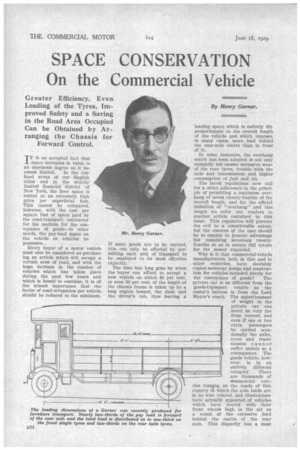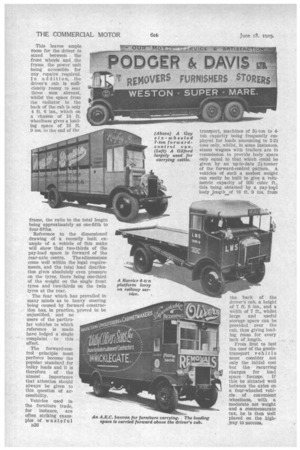SPACE CONSERVATION On the Commercial Vehicle
Page 86

Page 87

Page 88

If you've noticed an error in this article please click here to report it so we can fix it.
By Henry Garner.
IT is an accepted fact that space increases in value to an enormous degree as it be comes limited. In the confined areas of our English cities and in the strictly limited financial district of New York, the floor space is rented at an extremely high price per superficial foot. This cannot be compared, however, with the cost per square foot of space paid by the road-transport contractor for his medium for the conveyance of goods—in other words, the pay-load space on the vehicle or vehicles he possesses.
Every buyer, of a motor vehicle must also be considered as purchas
ing an article which will occupy a certain area of road, and with the huge increase in the number of vehicles which has taken place during the past few years and which is bound to continue, it is of the utmost importance that the factor of road occupation per vehicle should be reduced to the minimum. If more goods are to be carried, this can only be effected by permitting each unit of transport to be employed to its most effective capacity.
The time has long gone by when the buyer can afford to accept a new vehicle on which 40 per cent. or even 50 per cent. of the length of the chassis frame is taken up by a long engine bonnet, the dash and the driver's cab, thus leaving a
loading space which is entirely disproportionate to the overall length of the vehicle and .which imposes; in .many cases, more load behind the rear-axle centre than in front of it, . . .
In some instances, the overhang which has been adopted is not only , unsightly, but causes .excessive wear of the rear tyres, trouble with the axleand transmission and higher consumption of ,fuel and oil.
The latest regulations now call for a strict adherence to the principle of permitting a maximum overhang of seven twenty-fourths of the overall length, and for the official definition of " overhang " and this length we refer our readers to another article contained in this issue. This regulation will prevent the evil to a considerable extent, but the concern of the user should be to employ to greater advantage the remaining seventeen twentyfourths so as to ensure full return for the money expended.
Why is it that commercial-vehicle manufacturers, both in this and in other countries, have slavishly copied motorcar design and construction for vehicles intended purely for
the conveyance of goods? The private car is as different from the goods-transport vehicle • as 'the coster's barrow is from ,the Lord Mayor's coach. The apportionment of . weight in the private car can never be very far from correct, and even if one or two extra passengers be carried occasionally the axles, tyres and transmission cannot suffer unduly as a consequence. The goods vehicle, how-ever, is in an entirely different category. There are thousands of eommercial vehicles runnjng on the roads of this country id which the axle loads are in no wise related, and illustrations have actually appeared of vehicles which have reared with their front wheels high in the air as a result of the excessive load behind the centre of the rear axle. This disparity has a most evil effect on every part of the vehicle, and maintenance and running costs *rise considerably, whilst not only maythe life of the driver be imperilled but he is constantly worried by his lack of proper control, indifferent braking power and troubles with tyres, axles, etc.
The obvious solution of the diffleulty is to give greater attention to the embodying of forward-control or by overtyping. This gives proportionate carrying to the weight, more uniform pressure on the road surface, much easier and more posifive control, more satisfaction to the driver, and, last but not least, the principle constitutes a decided commercial advantage to the operator.
One would naturally ask why it is that forward-control or overtyping has not been universally adopted if it be so good, but a few moments' consideration will give the solution of this question in the one word,
accessibility. Many attemptsihave certainly been made to build chassis and bodywork to meet the requirements of this arrangement—and some with a considerable measure of success—but it must be confessed that the greater number, whilst looking exceedingly compact and quite attractive in external appearance, has turned into a " box of tricks," the vital parts of which cannot be got at without great difficulty even if a small adjustment only has 'to be effected, and it is this inaccessibility which has limited the demand for this otherwise admirable class of vehicle.
One maker of steam wagons has realized the enormous value of load space between the axles add has, with very satisfactory results, made a forward-controlled machine. A well-known maker of petrol vehicles has obtained accessibility by hinging the upper portion of the cab, whilst there is another patented design which gives the freedom desired whether the vehicle be loaded or unloaded, and it is just as easy to obtain access to important parts on the road as it is in the garage; everything is get-at-able without the detachment of any part of the body, the cab being made to swing open at each side, carrying on its hinges the side panels, side doors, the mudguards and cab floor.
This leaves ample room for the driver to stand between the front wheels. and the frame, the power' unit being accessible for any repairs required. In addition, the driver's cab is sufficientlyroomyto seat three men abreast, whilst the space from the radiator to the back of the cab is only 4 ft. 6 ins., which on a chassis of 14 ft. wheelbase gives a loading space of 16 ft.
ins, to the end of the frame, the ratio to the total length being approximately as one-fifth to four-fifths.
Reference to the dimensioned drawing of a recently built example of a vehicle of this make will show that two-thirds of the pay-load space is forward of the
rear-axle centre. The odimensions come well within the legal requirements, and the total load distribution gives absolutely even pressure on the tyres, there being one-third of the weight on the single front tyres and two-thirds on the twin tyres at the rear.
The forward-control principle must perforce become the popular standard for bulky loads and it is therefore of the utmost importance that attention should always be given to this question of accessibility.
Vehicles used in the furniture trade, for instance, are often striking examples of wasteful
D26 transport, machines of 34-ton to 4ton capacity being frequently employed for loads amounting to 2-2k tons only, whilst, in some instances, steam wagons with trailers are in commission to • provide body space only equal to that which could be given by an up-to-date 2-tonner of the forward-control pattern. A vehicles of such a modest weight can easily be built to give a volumetric capacity of 950 cubic ft., this being obtained by a pay-load body jength of 16 ft. 9 ins, from the back of the driver's cab, a height of 7 ft. 6 ins., and a width of 7 ft., whilst large and useful storage space can be provided over the cab, thus giving loading room for every inch of length.
From first to last the user of the goodstransport vehicle must consider not only the initial cost but the recurring charges for load space footage. If this be situated well between the axles on a four-wheeled vehicle of convenient wheelbase, with a Moderate net weight and a commensurate tax, he is then well placed on the highway to success,








































































































































































































